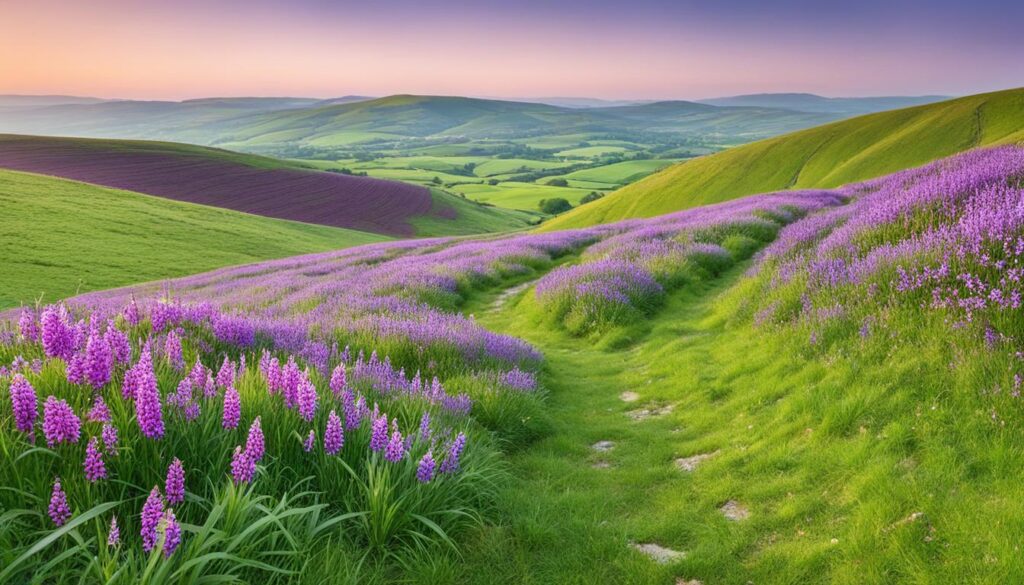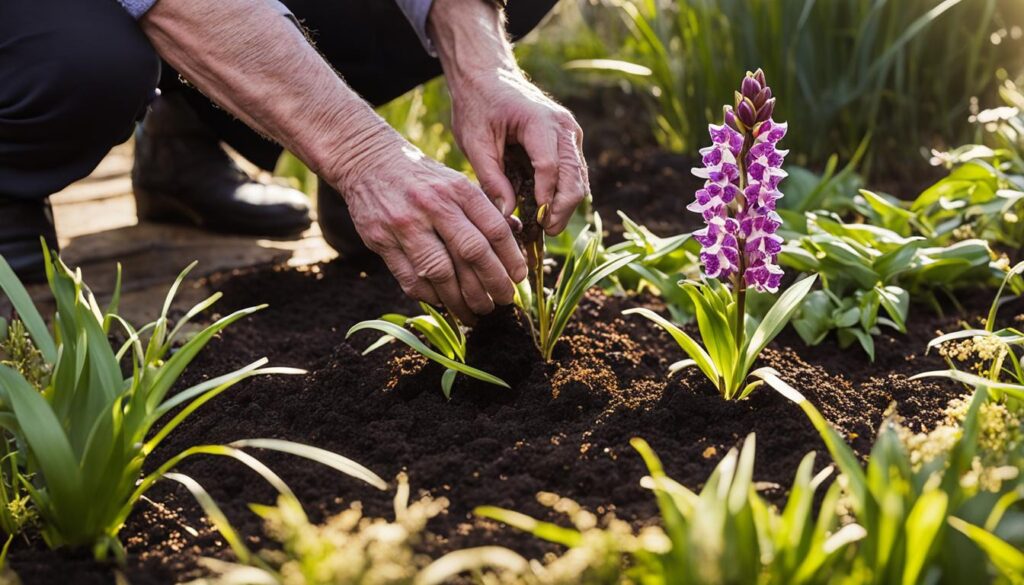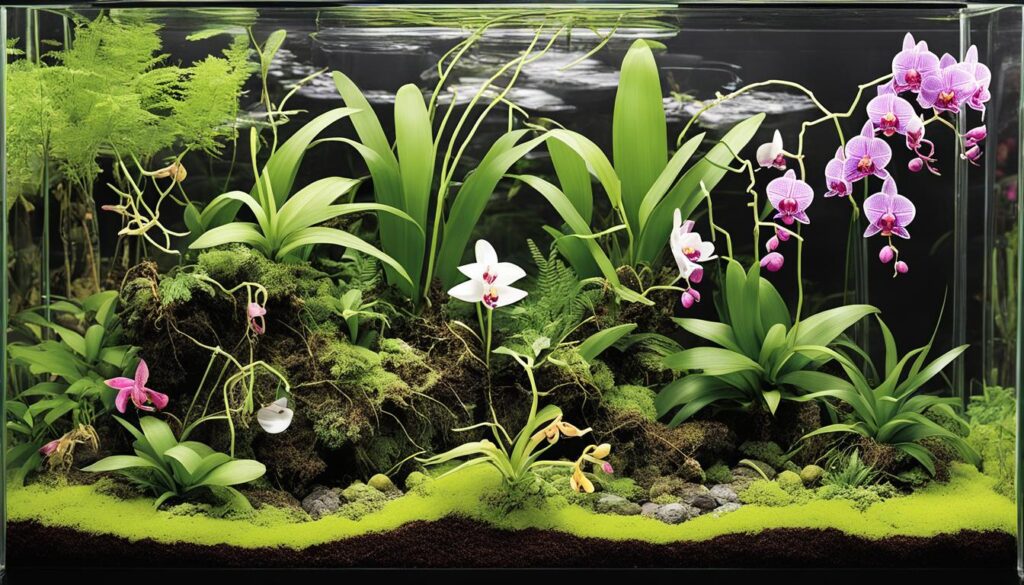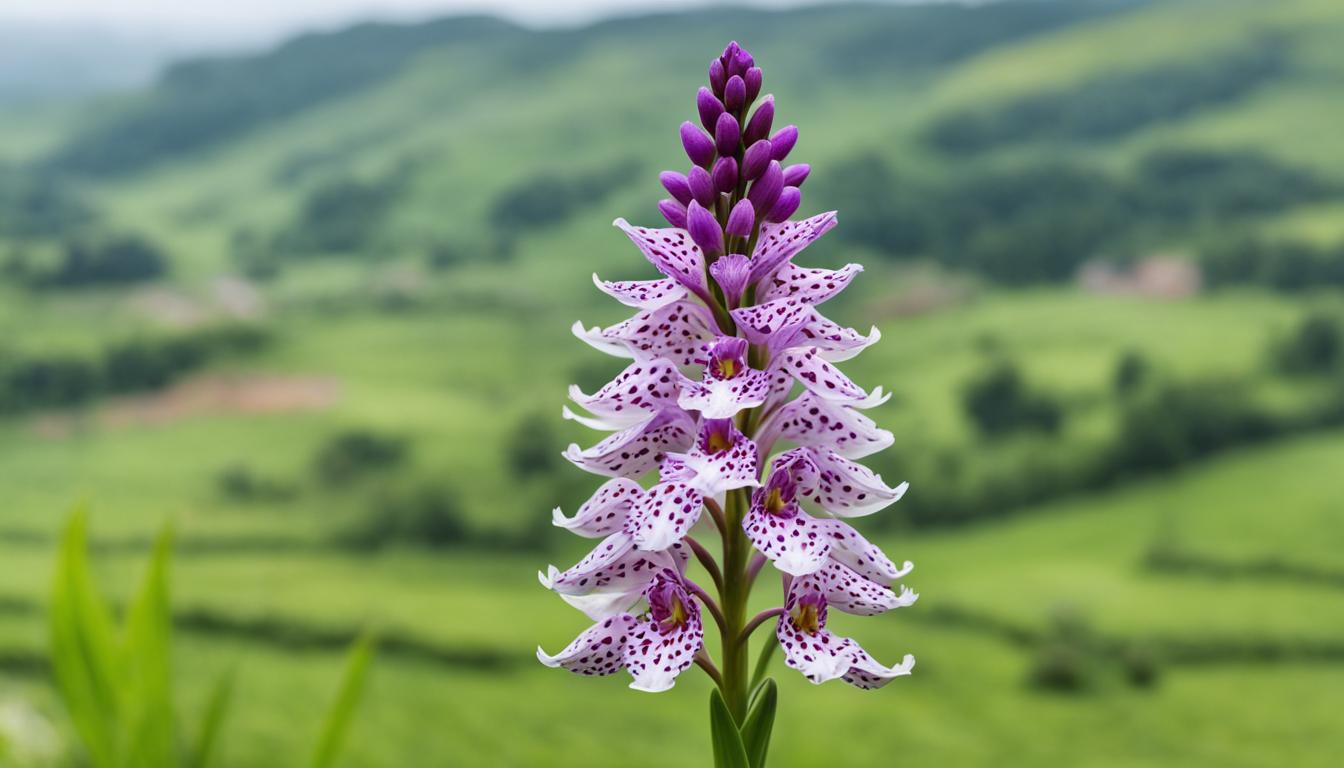During my wanderings through the serene countryside, I chanced upon a sight that captured both my curiosity and my heart: the Common Spotted Orchid.
Embedded in nature’s tapestry amidst lush forests and verdant coffee plantations, this wildflower stands as an emblem of the rich biodiversity native to places like Coorg, India.
As a native plant enthusiast, witnessing the variety of orchid species flourishing in the wild, from the dainty Foxtail orchid to the grandeur of Dendrobium, filled me with a sense of awe.
The cobweb of life in these rural regions is intricate, with each thread woven from the floras, such as Coelogyne and Bulbophyllum, contributing to the canvas.
But it was the encounter with the enchanting Bottle Brush orchid, or Liparis viridiflora, that truly signified the hidden treasures lying within the countryside.
It compelled me to understand and share the story of these orchids, especially the common spotted variety, and their relationship with the environment.
Key Takeaways
- Discovering the Common Spotted Orchid amid natural splendor accentuates the biodiversity of rural landscapes.
- Observing a variety of orchids, including the rare Coorg Liparis, highlights the importance of native plants.
- The nurturing climate and fertile lands in regions like Coorg provide ideal conditions for wildflowers to thrive.
- Experiencing the botanical beauty of the countryside invites appreciation for the rich tapestry of life it holds.
- Emphasizing the conservation of these ecosystems is crucial to maintain the harmony and vitality of species like the Common Spotted Orchid.
- Engaging stories of my encounters with these orchids offer insights into their unique charm and ecological significance.
Embracing the Pastoral Beauty: Why Countryside Orchids Captivate Us
Amidst the serenity of rural landscapes, I discovered a symphony of biodiversity that resonated through the delicate petals of orchids.
Their intricate beauty, a result of meticulous orchid care, intertwines with the fabric of the environment, painting a picture of nature’s masterful composition.
It’s this harmonious blend of flowering plants against the backdrop of vast pastoral canvases that draws us closer to the world of these fascinating species.
Intricacies of Orchids in their Natural Habitat
Orchids thrive on the subtleties of their surroundings. The Coorg region, known for its verdant hills and coffee scents, nurtured these flowering plants amidst trees that sifted the sun’s rays, filtering them into a gentle cascade of light.
This diffused sunlight, essential for their growth yet sparing them from the harshness of direct exposure, demonstrates how orchid care in the wild hinges on nature’s delicate balance.
Significance of Rural Landscapes for Biodiversity
The rolling hills and expansive plains characteristic of rural landscapes are not simply vistas to marvel at but are vital ecosystems supporting an array of plant species.
“In every walk with nature, one receives far more than he seeks,”
as famously stated by John Muir, which echoes true as we explore the interplay between climate, terrain, and biodiversity.
The diverse conditions – a mix of ample rainfall, cool temperatures, and diverse terrain – contribute to the prosperity of flora and fauna. Here’s a glimpse into how these landscapes nurture their botanical treasures:
| Condition | Benefit to Biodiversity | Example of Impact on Orchids |
|---|---|---|
| Ample Rainfall | Provides consistent moisture for growth | Ensures hydration critical to orchid health |
| Cool Temperatures | Limits pests and disease spread | Promotes longer blooming phases |
| Hilly Terrains | Creates unique microclimates | Supports a variety of orchid species |
As an advocate for biodiversity, I have noted the profound impact that conservation efforts within these rural settings can have. Orchid care, while pivotal, is just one aspect of the broader gestalt that shapes these regions.
By understanding and preserving the uniqueness of each landscape, we strengthen the natural threads that hold these ecosystems together.
Identifying the Common Spotted Orchid: A Floral Jewel Among Wildflowers
In my recent explorations of rural ecosystems, I have been captivated by the Common Spotted Orchid, a plant that distinguishes itself as a standout among its peers in the wilderness.
Having observed this species in various settings, from lush wetlands to serene woodlands, I’ve compiled insights into its distinctive features and its relation to other native garden plants.
Distinguishing Features of the Common Spotted Orchid
The allure of this particular orchid comes from its unique attributes that demand attention. As I journeyed through meandering meadows and shadowed woodlands, I noted its lance-shaped leaves marked with a distinctive spotted pattern.
Beyond the foliage, the Common Spotted Orchid presents a spike of purple and pink blooms that, to the discerning eye, are nothing short of enchanting.
There’s a symbiotic elegance in how this plant species not only thrives in its preferred habitats but also adds to the visual charm intrinsic to these environments.

Comparison with Other Native Plants
When pitted against other native plant species, the Common Spotted Orchid holds its own with grace.
It shares landscapes with the likes of Honeysuckle and Kidney Vetch, each with its own ecological and aesthetic significance.
The following table provides a concise comparison between the Common Spotted Orchid and these other native inhabitants of habitats such as Bryn Euryn and Pickleridge Lagoon:
| Plant Species | Habitat Preference | Distinctive Feature | Ecological Significance |
|---|---|---|---|
| Common Spotted Orchid | Meadows & Woodlands | Spotted Leaves & Elaborate Flowers | Pollinator Attraction & Biodiversity Support |
| Honeysuckle | Woods & Hedgerows | Fragrant Blossoms | Provides Nectar for Moths and Bees |
| Kidney Vetch | Grassy Places & Cliffs | Yellow Flower Clusters | Nitrogen Fixation & Soil Fertility |
The affinity of these native plants to their habitats cannot be overstated. There’s an inherent beauty in how they coexist and support the larger ecosystem, adding not only to the biodiversity but also to the very fabric that keeps the ecological balance in check.
As a naturalist and lover of garden plants, I find this interplay between flora to be a source of wonder and an argument for conservation.
It’s clear that each plant species when in its natural setting, plays a pivotal role in sustaining the health of our countryside.
Gardens and Wetlands: Cultivating the Common Spotted Orchid
Integrating the allure of wetlands into our backyard gardens infuses our flourishing green spaces with a rare charm.
As I delve into the essence of cultivating orchids, specifically the enchanting Common Spotted Orchid, my approach blends reverence for these delicate garden favorites with a commitment to orchid species conservation.
Adapting Garden Conditions for Orchids
Emulating the essence of a wetland’s embrace, I strive to transform segments of my garden into miniature havens for orchids.
It isn’t about simply planting; it’s about creating an environment where these beauties can thrive. The following steps are what I consider pivotal in adapting garden conditions for cultivating orchids:
- Ensuring a soft dappled sunlight mimics the natural canopy of their wild habitats.
- Maintaining a consistent moisture level by choosing substrates that mirror the water-retaining qualities of a wetland’s floor.
- Encouraging a diverse microbial environment to support the orchids just as a wetland would.
Role of Wetlands in Preserving Orchid Species
Wetlands are not just waterlogged landscapes; they are complex ecosystems that play a crucial role in orchid species conservation.
They act as nature’s nurseries, fostering a world where orchids and myriad other life forms coexist in a symphony of ecological balance. Below is a comparison highlighting their value:
| Feature | Garden Recreation | Natural Wetland |
|---|---|---|
| Light Exposure | Filtered through trees or shade nets | Natural diffusion through dense foliage |
| Moisture Retention | High-quality moisture-retentive soil mix | Inherently moist soil with rich organic matter |
| Microbial Diversity | Fostered through deliberate introduction of beneficial microbes | Naturally high due to the diverse flora and fauna |
| Conservation Value | Contributes to preserving species within controlled environments | Essential for the survival of innumerable wild species |
In essence, the wetland’s role is irreplaceable, yet through careful cultivation and garden design, I channel the essence of these natural, wild spaces into my own garden – fostering a little patch of sanctuary for my favorite specimens and contributing to their longevity.

A Botanist’s Diary: The Lifecycle and Ecosystem of Orchids
During my botanical studies in delicate and complex ecosystems, I’ve journaled the intricate orchid lifecycle with meticulous detail. These entries reveal the orchestration of life stages that orchids traverse, from tiny, almost dust-like seeds to mature plants boasting spectacular blooms.
As a plant that underscores the beauty and fragility of botanical ecosystems, orchids undergo a series of developmental stages linked to flowering plant cycles.
The germination phase itself pierces the veil of the mundane, requiring a specific type of fungi to initiate.
As I scribble down my observations, I note the symbiotic relationships that foster seed growth, a mesmerizing dance between two lifeforms for mutual benefit.
The emergence of a protocorm, and eventually, small leafed shoot is an event of such rarity and subtlety that it could escape the notice of an untrained eye.
With the progression to maturity, I witness the development of distinct floral structures, each carrying the potential to allure pollinators—a key aspect of the orchid’s survival. It’s here where these plants are most captivating, showcasing a diversity of colors and forms unparalleled in the plant kingdom.
The blossoming period so eagerly awaited ushers in the phase of pollination, where whimsical creatures such as bees, butterflies, and even birds partake in nature’s grand design.
The detailed entries in my diary underscore the essential conservation of these wonders, as I record how an orchid’s life is intimately tied to its native habitat.
Whether nestled in the dappled shade of the Coorg forest canopies or perched along wetland margins, their existence serves as a barometer for the health of their ecosystem.
The intentional nurturing of their surrounding environment thus becomes not only an act of preservation for the species but an homage to the beauty they represent.
Repeated observations and recordings form a complex tableau I diligently maintain, emphasizing the stages from pollination to seed dispersal.
In this final act, the tiny seeds are released to the wind, beginning the cycle anew, each hoping to find that perfect niche to call home—a testament to resilience and hope in nature’s grand narrative.

My diary, with its assorted sketches and annotations, bears witness to these floral marvels. It reflects the perpetual cycle of life that orchids demonstrate, the networks that sustain them, and the profound lessons they teach us about interconnectedness within botanical ecosystems.
Indeed, each entry celebrates the cycle of life that perpetuates species, a cycle that is intricate, fragile, and infinitely beautiful.
Exploring Orchid Care: Tips for Budding Enthusiasts
As I delve deeper into the world of gardening, I’ve learned that caring for orchids – these stunning garden favorites – requires more than a love for flowering plants; it mandates an understanding of their specific needs.
To share my insights on proper orchid care, I’ve compiled a list of essential tips and common pitfalls that every budding enthusiast should know.

Understanding the Essentials of Orchid Maintenance
Orchid care begins by replicating their natural tropical habitat, which means paying close attention to factors such as light, moisture, and the growing medium. Orchids thrive in bright, indirect sunlight.
Too little light will prevent blooming, while too much can scorch their leaves. Balancing these elements is key to witnessing the beautiful progression of your flowering plants.
Common Pitfalls in Caring for Flowering Plants
One of the greatest missteps in orchid maintenance lies in watering, either too much or too little can be detrimental.
Excessive moisture can lead to root rot, a common killer of orchids, while insufficient watering can dry them out, stunting their growth and bloom potential.
Let’s not forget the importance of temperature and humidity, which must be monitored to emulate the warm, humid conditions orchids adore.
Orchid Care Checklist:
- Ensure adequate indirect sunlight.
- Water judiciously to avoid root rot.
- Select the right substrate for potting.
- Maintain a consistent temperature and humidity level.
- Fertilize lightly, but regularly.
Common Pitfalls Table:
| Pitfall | Consequence | Avoidance Strategy |
|---|---|---|
| Inadequate Light | Impaired blooming | Position to receive indirect sunlight |
| Overwatering | Root rot | Follow a measured watering schedule |
| Poor Substrate Choice | Impeded drainage and aeration | Select an appropriate orchid mix |
| Incorrect Temperature and Humidity | Stress and potential pest infestations | Use humidifiers and heaters as required |
As with any journey in life, the path to mastering orchid care is an ongoing learning experience.
By avoiding these common pitfalls, I hope that enthusiasts will find joy in nurturing these exquisite flowering plants, solidifying their place as beloved garden favorites.
Conservation Challenges and the Role of the Orchid Hobbyist
As I delve deeper into the world of orchids, I’ve witnessed firsthand the conservation challenges these exquisite plants face.
Urbanization looms as a persistent threat, with wild habitats often succumbing to the rise of concrete structures that replace diverse, green canvases.
My interaction with other orchid hobbyists has reinforced a shared understanding: our passion for orchids imposes a responsibility to engage in sustainable practices -which can, in turn, play a pivotal role in protecting these botanical wonders.

Impacts of Urbanization on Wild Orchids
The continuous spread of urbanization directly impairs the delicate balance of ecosystems in which orchids thrive. My treks to undisturbed territories have often been marked by grim sights of deforestation and destruction, spaces that once flourished with a variety of orchid species now lay barren.
The ramifications are crystal clear: the loss of natural habitat not only endangers orchids but also disrupts the entire ecological network that supports them.
Sustainable Practices for Orchid Collecting
In addressing these formidable challenges, I’ve learned that sustainable orchid collecting is less about possession and more about preservation.
The essential practices are simple yet impactful. By supporting responsible nurseries that cultivate orchids, refraining from extracting these delicate species from the wild, and educating others about sustainable horticulture, we can collectively safeguard orchid populations.
Orchid hobbyists have a unique opportunity to blend their enthusiasm with conservation efforts, thereby ensuring the survival and proliferation of these cherished plants for generations to come.
Conclusion
My journey through pastoral landscapes has been an extraordinary revelation of the exquisite yet often overlooked marvels of nature.
This experience has afforded me a deeper appreciation for the countryside’s beauty and the botanical heritage that quietly resides therein. Every step taken amid the verdant greenery and blooming spectacles was a tribute to the native plants that form the tapestry of our natural world.
Each encounter, especially with the Common Spotted Orchid, served as a potent reminder of the intrinsic value these species hold and the urgent need for protecting native species.
Reflections on the Unseen Beauty of the Countryside
In the heart of forests and forgotten trails, the countryside beauty unfolds in a symphony of colors and scents.
The Common Spotted Orchid, with its delicate yet vibrant presence, emerges as a beacon of the unseen splendor that adorns our rural landscapes.
Its unassuming elegance is a testament to the rich botanical heritage that enriches our environment and perpetuates the biodiversity that is essential to ecological balance.
These natural wonders compel us to pause, observe, and cherish the nuanced artistry of our planet’s flora.
Passing the Legacy: The Importance of Protecting Native Species
As we forge ahead, it becomes paramount to protect the legacy of our native plants. The conservation of these species is not merely an ecological responsibility but also a moral imperative for ensuring the vitality and diversity of our ecosystems for posterity.
Our efforts towards protecting native species serve as a crucial step in sustaining the natural allure that shapes the character and health of the countryside.
By advocating for and implementing measures to preserve these botanical wonders, we have the opportunity to endow future generations with a world as abundant and varied as the one we have been privileged to savor.
FAQ
What makes the Common Spotted Orchid unique among wildflowers?
The Common Spotted Orchid is a native plant known for its distinctive botanic features, such as its leaves that display a spotted pattern and its ornate flowers, which make it stand out among wildflowers and draw the interest of nature enthusiasts.
Why are rural landscapes important for biodiversity?
Rural landscapes offer a combination of ideal weather conditions, terrains, and ecosystems, such as wetlands and woodlands, that support a diverse array of plant species, including various orchids. This diversity contributes to the ecological health and richness of the countryside.
How can gardeners cultivate the Common Spotted Orchid in their own gardens?
To cultivate the Common Spotted Orchid, gardeners should aim to replicate its natural wetland habitat, providing conditions like dappled sunlight, adequate moisture, and appropriate substrates that support the plant’s needs.
What is the role of wetlands in conserving orchid species?
Wetlands serve as natural nurseries, offering a moist and complex environment where orchid species, including the Common Spotted Orchid, can propagate and thrive. They play a crucial role in protecting these plants from environmental changes and aiding in their conservation.
Can you describe the lifecycle of orchids in their natural setting?
The orchid lifecycle in the wild is a compelling journey from seed to flower. It involves intricate symbiotic relationships with specific fungi for germination and pollinators for reproduction, underscoring the interconnectedness of orchids with their ecosystems.
What are essential orchid care tips for beginners?
For those new to orchid care, it’s critical to provide the right amount of light, ensure consistent but not excessive watering, and choose the correct substrate for the species. Learning about these needs is key to successfully growing orchids as garden favorites.
How does urbanization pose a threat to wild orchids?
Urbanization threatens wild orchid populations by leading to habitat destruction, as forests and natural landscapes are cleared for development. This places the survival of many orchid species at risk.
What sustainable practices can orchid hobbyists follow to protect wild orchid species?
Orchid hobbyists can help protect wild species by buying orchids from reputable nurseries instead of collecting them from the wild and advocating for and engaging in conservation efforts to preserve their natural habitats.
What can be done to ensure the protection of native species like the Common Spotted Orchid?
Protecting native plants such as the Common Spotted Orchid involves promoting conservation efforts, raising awareness about their ecological importance, and supporting sustainable practices that prevent the over-harvesting and habitat destruction of these precious species.


Leave a Reply